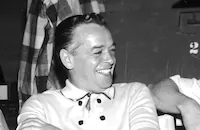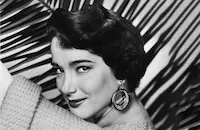In 1950, a gang robbed the Brink's Building in Boston and made off with almost $3 million. The Great Brink's Robbery, at the time the largest robbery in U.S. history (a record it held until 1984), was branded the crime of the century. It was only a matter of time before the movies dramatized the events.
Six Bridges to Cross (1955) is the first film based on the robbery. Officially, it is an adaptation of the story "They Stole $2,500,000 Million–And Got Away With It" by Joseph F. Dinneen, a condensed version of Dinneen's 1954 novel The Anatomy of a Crime; A Startling Parallel to the Fantastic $2,500,000 Brinks Robbery. Dinneen was a reporter for The Boston Globe and he drew extensively from his knowledge of the crime for a fictionalized account of the armed robbery. Six Bridges to Cross is only the first of numerous films based on or inspired by the real-life robbery, the best-known being William Friedkin's 1978 crime comedy The Brink's Job with Peter Falk and Peter Boyle.
Tony Curtis stars in this film as Jerry Florea, a tough kid from the slums who develops a close friendship with policeman Edward Gallagher (played by George Nader). Jeff Chandler was originally cast in the role of Jerry but dropped out over a contract dispute with Universal Studios. Curtis, at the time a heartthrob and rising star at the studio, took over the part. The studio had been throwing Curtis into every genre on its schedule: Westerns, romantic comedies, melodramas, swashbucklers, costume dramas, war films and more. Six Bridges to Cross played to the Brooklyn native's strengths, a streetwise kid who grows into a charming, cagey career criminal.
Chandler's absence turned out to be a blessing for young Sal Mineo, a veteran of the Broadway stage and television who had yet to appear in a feature film. His brother Mike had been cast to play Jerry as a boy thanks to his resemblance to Chandler, but Sal had accompanied him on the audition and also read for the role. When Curtis took over lead, the part was recast. "I replaced Mike since I looked more like Tony," wrote Mineo in 1957. "I was just lucky to have curly hair like Tony's." The film marked his big screen debut and gave him a crash course in film acting. Director Joseph Pevney "showed me the difference between stage and film techniques," Mineo recalled. "I learned to control my actions, which were fine for stage, but terribly exaggerated before cameras." Mineo became a star when he starred opposite James Dean and Natalie Wood in Rebel Without a Cause (1955).
Shooting began in Boston in the summer of 1954. Six Bridges to Cross was shot largely on location by cinematographer William H. Daniels, who earned an Academy Award for the New York-shot The Naked City (1948). He brought the same documentary-style approach to this project, which earned the film some of its most glowing notices. "The city of Boston, in fact, steals the picture," reads the review in The New York Times, which singles out the "Picturesque glimpses of urban thorough-fares and skylines" captured by Daniels. After location shooting wrapped, the production returned to the Universal lot in Hollywood to shoot the interiors.
Though he doesn't appear onscreen, Jeff Chandler still maintains a presence in the film. Not only does he provide uncredited narration, he co-wrote the movie's theme song, which was sung by his friend Sammy Davis Jr. Tragically, Davis was on his way to a recording session for the song when his car was involved in a serious crash. Davis survived but he lost his left eye. It was weeks before he had recovered enough to finally record the song that you hear in the film.
The film's premiere was held in Boston. There was a mob scene at the premiere, with thousands of people gathered including hundreds of teenage girls waiting for the arrival of star Tony Curtis. The actor prepared by putting on a trick shirt with sleeves attached by just a few threads so a photographer could snap a shot of the fans tearing his clothes off. As he wrote in his autobiography, "To the embarrassment of two ardent fans, the trick shirt worked to perfection."
Sources:
American Prince, Tony Curtis with Peter Golenbock. Harmony Books, 2008.
Sal Mineo, Michael Gregg Michaud. Crown Archetype, 2010.
"Call Me Junior," Sal Mineo. Seventeen, January 1957.
"The Screen in Review: 'Six Bridges to Cross' Opens at the Palace," H.H.T. The New York Times, January 22, 1955.
AFI Catalog of Feature Films
IMDb
By Sean Axmaker



























